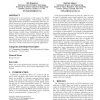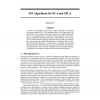58 search results - page 5 / 12 » Principal Component Analysis with Contaminated Data: The Hig... |
ACMACE
2007
ACM
13 years 11 months ago
2007
ACM
Fundamental to the generation of 3D audio is the HRTF processing of acoustical signals. Unfortunately, given the high dimensionality of HRTFs, incorporating them into dynamic/inte...
KDD
2001
ACM
14 years 8 months ago
2001
ACM
The similarity join is an important operation for mining high-dimensional feature spaces. Given two data sets, the similarity join computes all tuples (x, y) that are within a dis...
BMVC
2010
13 years 5 months ago
2010
We present a framework for the reduction of dimensionality of a data set via manifold learning. Using the building blocks of local hyperplanes we show how a global manifold can be...
PCM
2007
Springer
14 years 1 months ago
2007
Springer
The two-dimensional Principal Component Analysis (2DPCA) is a robust method in face recognition. Much recent research shows that the 2DPCA is more reliable than the well-known PCA ...
NIPS
1997
13 years 8 months ago
1997
I present an expectation-maximization (EM) algorithm for principal component analysis (PCA). The algorithm allows a few eigenvectors and eigenvalues to be extracted from large col...


